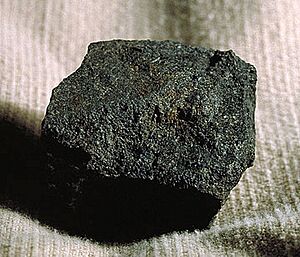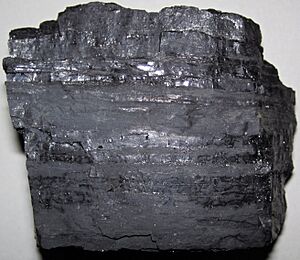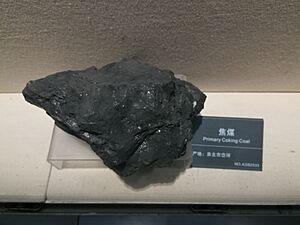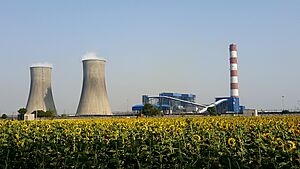Bituminous coal facts for kids
Bituminous coal, also known as black coal, is a type of coal that contains a tar-like substance called bitumen. It's usually black or dark brown and often has clear bands of shiny and dull material. This coal is typically hard, but it can break easily. Bituminous coal is ranked higher than lignite and sub-bituminous coal, but not as high as anthracite. It's the most common type of coal found around the world, often in rocks from the Carboniferous period. Bituminous coal forms from sub-bituminous coal when it's buried deep enough to be heated to about 85 degrees Celsius (185°F) or more.
Bituminous coal is mainly used to create electricity and in the steel industry. The type of bituminous coal used for making steel is called coking coal or metallurgical coal. This special coal must have very little sulfur and phosphorus. It costs more than other kinds of bituminous coal, which are used for heating and making electricity.
In coal mining, this type of coal is known for releasing a lot of firedamp. Firedamp is a dangerous mix of gases that can cause explosions underground. Because of this, mining bituminous coal requires very strict safety rules. These include carefully checking for gases, having good air circulation, and managing the mine site very carefully.
Contents
What is Bituminous Coal?
Bituminous coal is a specific rank of coal. Its rank depends on how much carbon it contains and how much energy it can produce when it burns. It ranks higher than sub-bituminous coal but lower than anthracite. Bituminous coal is the most common type of coal found.
Coal's rank is based on several features. The fixed carbon content tells us how much of the coal is pure carbon, not water, ash, or other gases. An agglomerating coal is one that softens when heated. It forms a hard, porous coke that is strong.
Bituminous coal is dark brown to black. It's hard but can break easily. You can often see thin bands of bright and dull material within it. While its exact chemical makeup can vary, a typical piece of bituminous coal is about 84.4% carbon, 5.4% hydrogen, 6.7% oxygen, 1.7% nitrogen, and 1.8% sulfur by weight. When it burns, it usually creates a smoky flame and softens. It gets its name from this tendency to become soft and sticky when heated, which is due to the bitumen (a type of mineral tar) inside it.
How is it Used?
Bituminous coal is mainly used to make electricity and to produce steel.
Coking Coal
Coking coal, also called metallurgical coal, is used to make steel. Good coking coal must soften well when heated, have a lot of carbon, and be low in sulfur, phosphorus, and ash. The best coking coal is usually a high-quality medium-volatile bituminous coal. However, it's rare to find one coal with all these perfect qualities. So, coking coal is often a mix of different types of bituminous coal.
Smithing coal is the best quality bituminous coal. It has very little ash and sulfur. Blacksmiths use it to make coke for their work.
Coking coal costs more than coal used just for energy. For example, in 2020, coking coal in the U.S. sold for about $127 per short ton. Other bituminous coal used for power cost about $50.05 per short ton.
Thermal Coal
Bituminous coal that isn't good enough for making steel is called thermal coal. This type is mostly used to generate electricity. The best thermal coal catches fire easily and produces a lot of heat.
Activated Carbon
Bituminous coal can also be used to make activated carbon. This is done by first heating the coal to remove gases, then treating it with steam. Activated carbon is used in filters and other products.
Where Does it Come From?
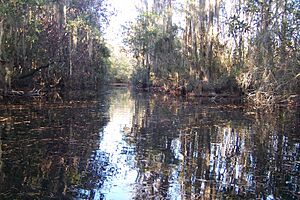
Like other types of coal, bituminous coal forms from large amounts of dead plants. These plants get buried faster than they can rot. This usually happens in peat bogs, where dead plants fall into still water. The water keeps oxygen out, creates an acidic environment, and slows down decay. Over time, the dead plant material turns into peat.
Peat is mostly made of cellulose, hemicellulose, and lignin, which are parts of woody plants. As peat turns into coal, a process called carbonization happens. This process removes most of the oxygen and a lot of the hydrogen from the plant material, leaving mostly carbon.
As coal forms, it gets more carbon, loses hydrogen and other gases, produces more heat when burned, and becomes darker and shinier. Chemical changes include removing oxygen and hydrogen as water or carbon dioxide, and removing hydrogen as methane. By the time coal becomes bituminous, most of the water and carbon dioxide have already been removed. The formation of bituminous coal is marked by the removal of methane.
During coal formation, the pressure of being buried shrinks the original peat by about 30 times as it turns into coal. However, the most important factor for coal's rank is the highest temperature it reaches. Bituminous coal forms at temperatures between 85 and 235 degrees Celsius (185-455°F). The bitumen that gives bituminous coal its name forms under similar conditions to how petroleum (oil) is made. This process also creates a lot of methane in medium to low volatile bituminous coal. This is why these coals are "gassy," and miners must be careful to prevent methane explosions. If the coal gets hotter than about 235 degrees Celsius (455°F), the bitumen breaks down, and the coal turns into anthracite.
Where is it Found and Produced?
Coal deposits are found all over the world. They range in age from about 360 to 420 million years old, up to just a few million years old. However, 90% of all coal beds formed during the Carboniferous and Permian periods. These periods only make up 2% of Earth's history! Huge amounts of coal formed in wetlands, called coal forests, which covered much of Earth's tropical land during the late Carboniferous and Permian times. Bituminous coal is mostly from the Carboniferous period.
Most bituminous coal in the United States is between 100 and 300 million years old. Large deposits of Pennsylvanian-age bituminous coal are found in the Appalachian and Interior regions of North America. Mining is done both above ground (surface mines) and underground. Appalachian coal often has low sulfur and is good for making steel. Coal from the Interior Province has much higher sulfur.
The belt of Carboniferous coal fields stretches into central Europe. Much of this is bituminous coal. You can find bituminous coal fields in Poland and the Czech Republic. Poland's deposits are a very important natural resource for that country. The Czech deposits have been used since ancient times. European deposits also include Britain's Coal Measures, which are mostly bituminous coal. Other important deposits are in France, Germany, and northern Italy.
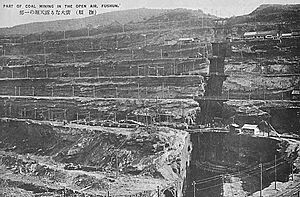
Coal formation paused during the Permian-Triassic extinction event, but it started again later in the Permian period. Large bituminous coal deposits from the Permian age are found in Siberia, East Asia, and Australia. These include areas like the Minusinsky coal basin in Siberia, and the Queensland, Bowen, and Sydney Basins in Australia. China also has huge amounts of bituminous coal.
Another period of major coal formation began in the Cretaceous period. However, most of this coal is lower rank than bituminous. In the United States, Cretaceous bituminous coals are found in Wyoming, Colorado, and New Mexico. In Canada, the Western Canadian Sedimentary Basin in Alberta and British Columbia has large deposits of bituminous coal. These formed in swamps along the western edge of the Western Interior Seaway.
As of 2009, the countries with the most estimated bituminous coal resources were the US, India, China, Australia, South Africa, the UK, Germany, Colombia, Indonesia, and France.
In 2018, the world produced 6.220 billion tons of bituminous coal. China was the top producer, with India and the United States far behind in second and third place.
In 2020, the U.S. produced 238 million short tons of bituminous coal, which was 44% of all U.S. coal production. Bituminous coal is mined in 18 states, but West Virginia, Pennsylvania, Illinois, Kentucky, and Indiana produce 74% of the U.S. total.
Safety and the Environment

As bituminous coal forms, especially the medium and low volatile types, it creates a lot of methane gas. This makes these coals "gassy," and miners must take precautions to prevent methane explosions. Special liquids can also help reduce the risk of the coal catching fire on its own.
Bituminous coal was once widely used to heat homes in the U.S. However, it's a relatively "dirty" fuel. Using less bituminous coal between 1945 and 1960 is thought to have saved many lives each winter month. The quality of bituminous coal can be improved using special cleaning methods, which make it burn cleaner.
Scientists are also looking into ways to turn bituminous coal into methane using biological processes. This could be a cleaner way to use coal in the future.
See also
- Coal analysis
- List of rock types


